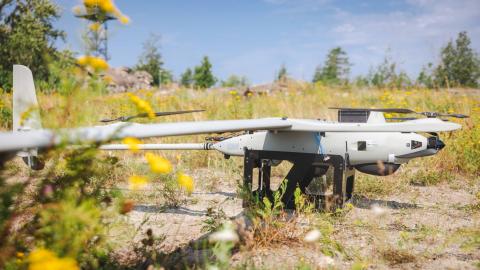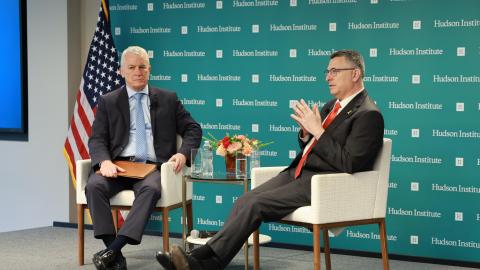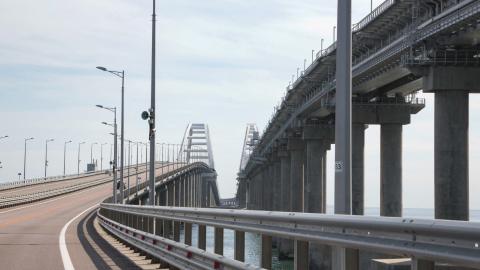The understandable concerns about renewed terrorist violence in the United States should not obscure the imperative of defending the homeland against higher-end threats such as missile attacks. Adverse international security developments are worsening these threats. In response, Congress needs to work with the Pentagon to strengthen currently available defenses while developing superior future technologies.
China and Russia have many long-range missiles targeting the United States, but the probability of their launching them is remote. Notwithstanding their disturbingly assertive policies in recent years, neither country’s leaders are suicidal. If they attack us, the United States could destroy them.
A more serious problem is that China and Russia have transferred missile systems and other dangerous technologies to countries like Iran, Syria, and North Korea that might prove less reluctant to threaten the United States. Setting aside legitimate doubts about how effectively threats of retaliation could deter these governments, these regional troublemakers rationally want asymmetric technologies like missiles to compensate for their much weaker conventional military capabilities.
Some of these transfers may have occurred without the approval, or even knowledge, of the national governments of China and Russia. Entrepreneurial Chinese and Russian groups have evinced a disturbing eagerness to sell any client, no matter how odious, the most dangerous items.
At another level, however, both Beijing and Moscow want to weaken the United States by proliferating so-called anti-access/area-denial weapons, such as missiles and mines, that states threatening U.S. interests could use to deter U.S. countermoves. That is one reason why China and Russia are so hostile to the U.S. ballistic missile defenses (BMD) supporting America’s friends and allies in Europe, Asia, and the Middle East. By negating missile threats, BMD systems enhance the U.S. ability to counter regional aggression.
Although Iranian leaders have recently moderated their tone to secure relief from international sanctions, they still insist on their right to develop better missiles that could strike Israel, Europe, and, if possible, the United States. If Tehran again cheats on its pledges not to seek nuclear weapons, Iran could arm these missiles with nuclear warheads.
North Korea represents a more serious threat to U.S. interests. Pyongyang has pursued without pause the means to launch nuclear weapons against the United States. Its leaders see America as the main barrier to their aspirations to forcefully reunify the Korean Peninsula, export nuclear and missile technologies, and blackmail other countries. When annoyed with Washington, North Korean leaders readily boast of their intent to nuke the United States.
Despite many setbacks, North Korea, sometimes with Iranian and other foreign help, has made major unanticipated breakthroughs in its missile capabilities. Pyongyang has already attained the ability to send satellites into space—a capability that is similar to that required to deliver a nuclear warhead against the U.S. homeland—and probably has deployed mobile missile launchers that will prove less vulnerable to U.S. preemption.
The United States now has a small number of ground-based interceptors in Alaska and California designed to shoot down a few long-range missiles. This Ground-Based Midcourse Defense system complements the shorter-range BMD systems that the United States and its allies have deployed in Europe, Asia, and the Middle East.
To increase U.S. homeland defense capabilities, the Pentagon wants to deploy more interceptors in the next few years while developing better capabilities in the future. The long-term goal is to develop a better kill vehicle, more affordable and reliable defenses against cruise as well as ballistic missiles, and means of destroying missiles before they are launched with preemptive strikes, space-based systems, and non-kinetic weapons.
However, a conference in early December at the Center for Strategic and International Affairs made clear that it will take years to design, develop, and deploy potentially breakthrough technologies, including the so-called Multiple Object Kill Vehicle. Simply waiting years until these next-generation BMD systems are ready while suspending augmentation of currently available technologies would be excessively risky, especially given that an unexpected North Korean or Iranian missile threat to the U.S. homeland could emerge before the new technologies are ready.
For this reason, Congress should fully back the Pentagon’s plans to deploy additional current-generation interceptors in Alaska while upgrading their supporting sensor and infrastructure capabilities, and pursuing a shorter-term redesigned kill vehicle that builds on successes and improvements already achieved. More frequent tests of this national missile defense architecture are also needed. Although unable to negate the massive missile arsenals of China and Russia, the existing hit-to-kill technology clearly works. The Missile Defense Agency is confident that the available systems could destroy an incoming Iranian or North Korean missile. With more interceptors, the prospects of a successful intercept increase.
Although the costs of defending the U.S. homeland against missiles and other threats are high, the price of the destruction of a U.S. city would be immeasurable. There is bicameral and bipartisan support for boosting missile defense spending, but shortfalls persist due to competing priorities and overall budget constraints. Yet no congressional responsibility is more important than protecting the American people against such threats.















